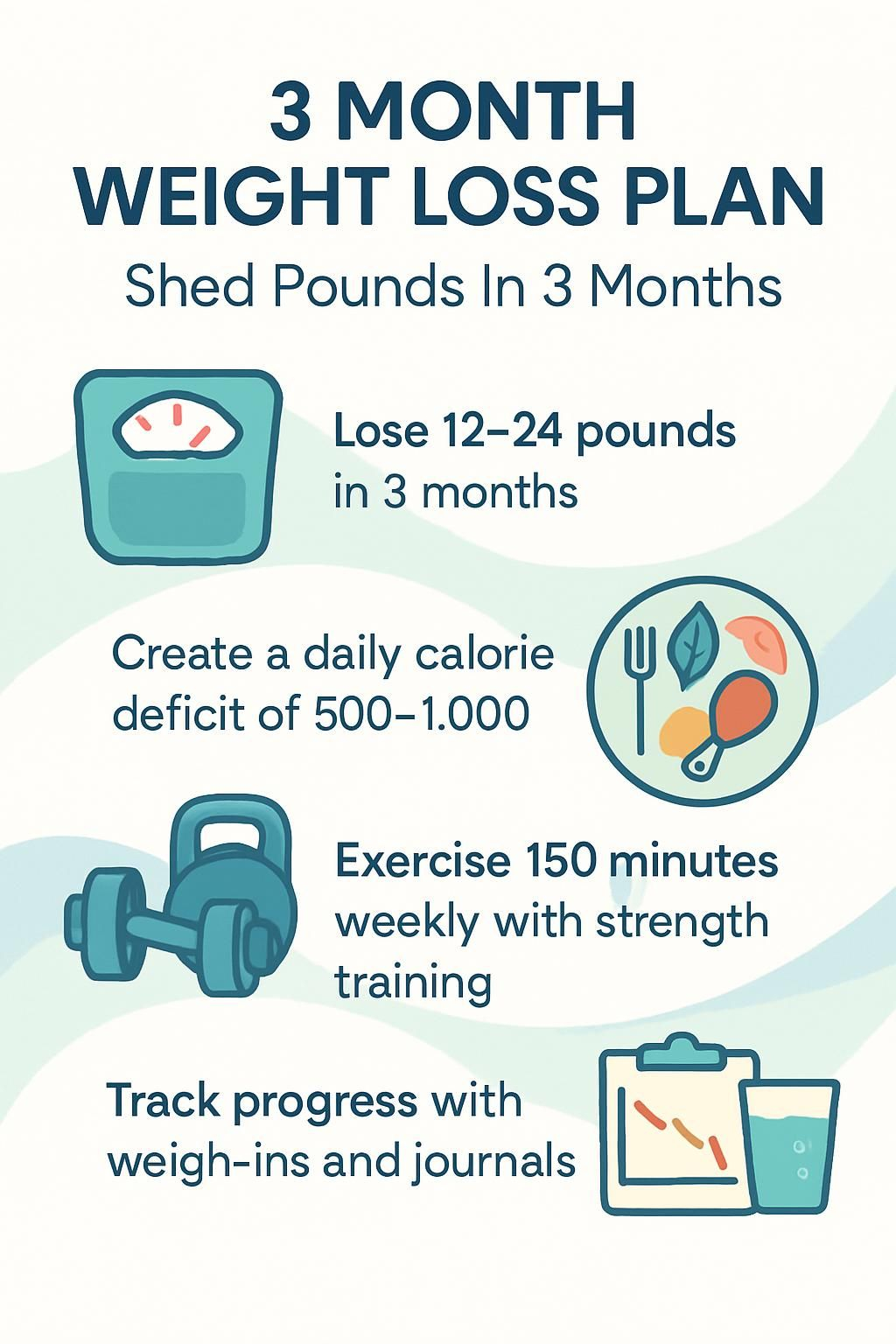3 Month Weight Loss Plan: Shed Pounds In 3 Months
Our Nutrition Assistant AI Suite will transform your body. You will lose fat, get toned, and build muscle. Gain confidence and optimal health.
Trying to lose weight but unsure where to start? A clear 3 month weight loss plan can make the path simple and safe. Research and public health guidance suggest that losing 12 to 24 pounds in three months is realistic for most adults.
This guide shows you how to set smart goals, build a calorie deficit, and install habits that last. You will learn how to shed pounds in 3 months and keep your progress long after the plan ends.
Key Takeaways
- Health agencies like the CDC suggest a pace of 1 to 2 pounds per week, which equals about 12 to 24 pounds across three months.
- A daily calorie deficit of 500 to 1,000 supports steady fat loss. Do not go below 1,200 calories for most women or 1,500 for most men without medical supervision.
- Pairing 150 minutes of moderate cardio with strength training each week is highly effective for fat loss and muscle maintenance, according to the American Heart Association.
- Lean protein and fiber-rich foods help control hunger and protect metabolism. Limiting ultraprocessed foods reduces the risks tied to rapid weight loss.
- Weekly weigh-ins, food logs, and social support improve accountability and increase long-term success.

Evaluating the Safety of a 3-Month Weight Loss Plan

A 3-month weight loss plan can be safe if you follow science-based steps. Set goals that protect your health and fit your lifestyle. Small changes add up over time.
What is a safe rate for losing weight?
Experts at the Centers for Disease Control and Prevention say losing 1 to 2 pounds per week is a safe and sustainable pace. Many dietitians agree because it supports long-term weight management and reduces health risks.
A daily calorie deficit of 500 to 1,000 calories often leads to 4 to 8 pounds lost per month. This pace helps protect muscle, which keeps your metabolism steady. Trying to lose more than this can push people toward very-low-calorie diets or extreme workouts, which are risky without medical guidance.
In my experience, a slower pace led to stronger habits and better weight maintenance after the three months ended.
“Losing one or two pounds each week allows you to reach your goals in a way that protects both your body and mind.”
What are the risks of losing weight too quickly?
Rapid weight loss from severe calorie cuts can cause more harm than good. You can lose muscle instead of fat, which lowers metabolism and makes regaining weight more likely.
Possible problems include fatigue, hair thinning, and lower bone density. Nutrient gaps weaken the immune system, which may raise your chance of getting sick. Quick fixes rarely fuel your brain well, so focus and energy often drop.
Many people who use extreme diets face weight cycling, also called yo-yo dieting. Pounds return once normal eating starts. The Academy of Nutrition and Dietetics warns that chasing 30 pounds lost in three months raises the risk of malnutrition and vitamin shortages.
During college, I pushed a strict plan and lost weight fast, then felt drained and unfocused. Most of the weight came back within weeks.
How do I set achievable weight loss goals?
Goals should match your schedule, health, and current weight. Aim for one to two pounds per week, which makes 12 to 24 pounds lost in three months a realistic target for many adults.
Calculate a calorie goal that creates a steady deficit, often 500 to 1,000 fewer calories than maintenance. Age, sex, activity, and health conditions all affect your numbers. If you have a medical condition or take medicines that affect weight or blood sugar, talk with a healthcare professional first.
After graduation, I worked with a registered dietitian to lose fifteen pounds. The guidance helped me track progress safely and enjoy balanced meals without guilt.
Components of an Effective 3-Month Weight Loss Strategy
A strong plan mixes clear goals, steady habits, and weekly follow-through. Focus on daily actions you can repeat. Consistency beats perfection.
How do I define realistic weight loss objectives?
Set a safe pace, 1 to 2 pounds per week. It takes about 3,500 calories to lose one pound of body fat. For many adults, 12 to 24 pounds in three months is both safe and realistic.
Theresa Gentile, RD, notes that gradual loss helps prevent nutrient gaps and supports weight maintenance. Pick a specific number within the safe range, like 15 or 20 pounds, and map small weekly steps to reach it.
Clear objectives make progress easier to track and keep motivation high.
How do I calculate the right calorie reduction?
First, estimate how many calories you need to maintain your weight. Factors include age, sex, height, weight, and activity. Use a trusted calculator or ask a healthcare provider for help.
For steady loss, create a 500 to 1,000 calorie daily deficit. Most people will lose about one to two pounds per week with this approach. Do not drop below 1,200 calories for many women or 1,500 for many men unless under medical care.
Dietitian Lena Beal explains that trying to lose 30 pounds in three months often means an extreme daily deficit near 1,250 calories. That is hard to sustain and may harm health. I once tried a large cut and felt weak during work and exercise. A moderate target was easier to maintain.
What healthy lifestyle habits should I establish?
Build habits that support weight loss and your overall well-being. Focus on practical actions you can repeat every week.
- Eat balanced meals. Include lean protein, healthy fats, and fiber-rich carbs to stay full and nourished.
- Drink water often. Hydration helps appetite control and can reduce cravings for sugary drinks.
- Protect your sleep. Aiming for 7 to 9 hours supports hunger hormones and weight control.
- Plan weekly meals. A simple plan limits impulsive eating and keeps your budget in check.
- Move regularly. Combine aerobic exercise with strength training to burn calories and protect muscle.
- Track behavior. Use a food journal, app, or glucose monitor if advised to guide adjustments.
- Find support. A group, partner, or trainer boosts motivation and accountability.
- Limit ultraprocessed foods. Favor fruit, vegetables, whole grains, and protein-rich options.
- Manage stress with yoga or breathing exercises. Chronic stress can raise appetite.
- Stay active daily. Short walks or at-home calisthenics add up without special equipment.
For me, logging meals in an app and walking 30 minutes a day made weight control doable during busy weeks.
Nutritional Guidelines for Losing Weight
Nutrition drives most of your results. A balanced plate helps you control hunger, protect muscle, and keep energy steady all day.
How can I plan a long-term healthy diet?
Estimate your daily calorie needs based on age, sex, activity, and health status. The USDA suggests many adult women may need 1,600 to 2,400 calories per day and many adult men may need 2,000 to 3,000.
Avoid dropping below 1,200 calories for most women or 1,500 for most men unless guided by a clinician. Skipping meals or using crash diets can drain your energy and mood.
Choose whole foods like fruits, vegetables, lean proteins, legumes, and whole grains. Include protein and fiber in every meal. These nutrients slow digestion and help you feel full longer. Limit added sugars and refined snacks. Slow changes create habits that last.
What are the benefits of a balanced nutritional intake?
A balanced mix of protein, fats, and carbohydrates gives steady energy and reduces cravings. Dietitian Theresa Gentile recommends building each meal around lean proteins, healthy fats, and high-fiber starches.
Overly strict diets that cut whole food groups raise the risk of nutrient deficiencies and low energy. A balanced diet helps protect muscle while you lose weight, which supports your metabolism.
Research links balanced eating patterns with better long-term weight maintenance and lower cardiovascular risk. During my three-month plan, keeping variety on my plate prevented boredom and made calorie targets easier to hit.
Why focus on protein-rich and fiber-rich foods?
Protein helps preserve muscle during weight loss. Since muscle burns more calories than fat, keeping it supports your metabolism. A higher protein intake often improves fullness between meals.
Fiber from foods like oats, beans, and whole grains slows digestion. That helps control hunger and supports digestive health. During my plan, meals built around chicken, lentils, and brown rice eased cravings for sweets and provided steady energy for weight training and squats.
How can I limit processed and sugary foods?
Swap snack foods for simple options like fresh fruit, nuts, or plain yogurt. Build meals around vegetables, lean proteins, and high-fiber carbs to stay full longer.
Studies show lower intakes of ultraprocessed foods reduce total calories and improve diet quality. Cut back on sugary drinks by choosing water or unsweetened tea. In the store, spend more time in the produce and fresh food sections. Check labels to spot added sugars and hidden fats. These steps lower calories across three months without leaving you hungry.
Exercise Recommendations for Weight Loss
Exercise speeds progress and protects muscle while you reduce calories. A balanced routine is easier to stick with and supports long-term health.
How do I mix cardio and strength exercises effectively?
Combine both. Aim for at least 150 minutes of moderate cardio each week, such as brisk walking, swimming, or cycling. A 150-pound person may burn around 500 calories with a brisk 4 to 5 mile walk or an hour of steady lap swimming.
Strength train two to three times weekly with moves like squats, lunges, and push-ups. Muscle burns more calories at rest, so protecting it helps you keep weight off. Cardio increases calorie burn now, strength training supports metabolism later. I alternated cardio days with strength sessions and saw steady progress, plus better stress control.
Pair your workouts with a calorie deficit for the best results.
How can I ensure workout consistency?
Consistency matters more than intensity at the start. Build a routine that fits your life, then improve it over time.
- Set a regular workout time to anchor the habit.
- Rotate cardio, squats, and strength work to avoid boredom.
- Track sessions with a log or app to stay accountable.
- Keep simple equipment visible, like bands or dumbbells.
- Find a partner or group for support and encouragement.
- Begin with three 30-minute sessions per week, then progress.
- Celebrate milestones such as sessions completed or inches lost.
- Include rest days to prevent injury and burnout.
- Keep your goal in view to reinforce consistency.
Next, explore flexible home options to make steady exercise easier.
What are some good exercise options at home?
Home workouts save time and can be quite effective. Mix cardio and strength choices to keep progress steady.
- Brisk walking or jogging in place raises heart rate and supports calorie burn.
- Bodyweight squats strengthen major muscles and need no equipment.
- Push-ups build upper body strength and support fat loss.
- Resistance bands add portable strength work with many levels.
- Jump rope boosts heart health and burns many calories in minutes.
- Yoga or stretching builds flexibility and calms the mind.
- Dancing keeps you moving and lowers stress.
- Stair climbing builds leg strength and stamina using what you have.
- Planks strengthen your core with short, focused holds.
- Online workout videos provide structure at home without a gym.
- Mixing options keeps workouts fresh and helps you lose pounds in three months.
What are the benefits of walking and gentle exercises?
Walking burns calories with low injury risk. A 150-pound person can burn roughly 500 calories with a brisk 4 to 5 mile walk. Gentle routines like stretching or yoga help your body adapt without strain.
These activities are easy to stick with for three months. I began with neighborhood walks before adding harder sessions like squat exercises. Small steps build confidence and protect your joints.
Lifestyle Adjustments for Weight Loss
Small daily changes add up to big results. A few tweaks to sleep, stress, and hydration can move the scale in your favor.
How can I improve sleep quality and manage stress?
Poor sleep and high stress can slow or reverse progress. Better sleep supports hormones that regulate hunger. Stress control helps prevent emotional eating.
- Keep a consistent sleep schedule to steady appetite hormones.
- Limit screens at night to avoid blue light that disrupts melatonin.
- Make your room cool, dark, and quiet for deeper sleep.
- Aim for 7 to 9 hours of sleep, since short sleep links to higher BMI.
- Practice relaxing methods such as breathing exercises or yoga.
- Write in a journal or talk with a friend to reduce mental load.
- Drink water through the day, since dehydration can worsen stress.
- Take a 20-minute outdoor walk to ease anxiety and improve sleep.
- Seek help from a clinician if sleep or stress stays high.
- Track sleep and stress with an app or diary and adjust as needed.
Why is staying hydrated important for weight loss?
Water supports metabolism and helps control appetite. Drinking water before meals often reduces calorie intake. Adequate fluid intake also fights fatigue, which can derail healthy choices and workouts.
On my own plan, keeping a refillable bottle nearby made energy steadier and progress more consistent week to week.
How do I monitor progress and stay accountable?
Tracking turns effort into data. Those numbers guide adjustments and keep you engaged during the 3-month weight loss plan.
- Weigh in once a week at the same time with the same scale.
- Measure waist, hips, and arms every two weeks to capture changes.
- Track calories and exercise in a journal or app to hold a steady deficit.
- Take monthly photos to see changes that the scale might miss.
- Share goals and updates with a friend or group for accountability.
- Schedule check-ins with a dietitian or join an online support group.
- Set small goals, such as more steps or extra vegetables.
- Review your notes weekly and adjust based on patterns, not guesses.
- Use phone reminders for workouts and meal prep.
- Celebrate milestones with non-food rewards.
- Track energy, mood, and sleep, since health gains may show up before the scale moves.
How can I build a supportive community?
Support helps you stay consistent, especially on hard days. A positive circle also gives you ideas and fresh motivation.
- Join online weight loss groups for tips and encouragement.
- Find a workout buddy to add commitment and fun.
- Attend local or virtual programs, such as Weight Watchers, for structure.
- Share your goals with family or friends to build support at home.
- Post progress in an app or group chat to celebrate wins.
- Try group classes or team challenges for friendly competition.
- Encourage others. Supporting them strengthens your own commitment.
- Seek mentors who have reached similar goals and learn from their path.
Step-by-Step 3-Month Weight Loss Plan
Structure keeps you moving forward. Each month builds on the last, guiding you from set-up to results.
What should I focus on in Month 1 to establish basics?
Start strong with simple daily actions. The goal is a steady calorie deficit and habits you can repeat.
- Track everything you eat and drink to spot easy cuts.
- Set a 500 to 1,000 calorie daily deficit to aim for 1 to 2 pounds per week, as the CDC recommends.
- Plan meals with lean protein, healthy fats like olive oil or avocado, and high-fiber carbs such as brown rice.
- Limit processed snacks and cut back on sugary drinks to steady blood sugar.
- Exercise at least 150 minutes per week. Mix walking, cycling, or swimming with two days of basic strength moves.
- Check progress weekly and adjust as needed.
- Keep a consistent bedtime to support fat loss and hunger control.
- Drink at least eight cups of water daily.
- Adopt one new healthy habit each week, like a daily breakfast or less screen time at night.
- Share your goals with a supportive person or group.
- Meal prepping on Sundays kept me from last-minute takeout and made portion control easier.
How can I boost intensity and sharpen focus in Month 2?
Build on your base. Increase effort carefully so you keep good form and energy.
- Add 10 to 15 minutes to workouts or increase speed or resistance.
- Do at least two strength sessions per week to build muscle and raise calorie burn.
- Track calories, protein, and fiber to hold a healthy deficit.
- Reduce processed and sugary foods further. Swap sweets for fruit or yogurt.
- Review weight, measurements, and workouts weekly to catch plateaus early.
- Move more outside workouts, like taking stairs or walking during breaks.
- Refocus on sleep and stress skills, such as deep breathing or journaling.
- Keep water intake near eight cups daily to cut false hunger.
How do I perfect habits and evaluate results in Month 3?
Month 3 is for fine-tuning. Stay consistent, then make small improvements you can maintain.
- Weigh weekly and compare with your 12 to 24 pound goal. The CDC endorses 1 to 2 pounds per week.
- Review food logs to confirm a balanced diet with protein and fiber for fullness and recovery.
- Keep a mix of cardio and strength, at least 150 minutes weekly per AHA guidance.
- Track sleep and stress, since both shape fat loss and habit strength.
- Try fresh meal prep ideas or new workouts to prevent boredom.
- Use photos or how clothes fit to see progress beyond the scale.
- Share updates with a supportive person or group to boost accountability.
- List challenges from Months 1 and 2 and plan fixes for each one.
- Draft a maintenance plan to prevent regain. Keep core habits and adjust calories as needed.
Overcoming Weight Loss Obstacles
Every plan hits bumps. Simple, evidence-based adjustments help you keep moving forward.
How do I overcome weight loss plateaus?
Plateaus are common after early progress. Slightly lower daily calories, such as by 100 to 200, or raise activity. Add intervals to cardio or include an extra strength session.
Keep protein intake high to protect muscle. Track meals closely for a few days to find hidden calories from sauces or snacks. If the stall continues, a registered dietitian can tailor strategies to your needs. Many people break plateaus by shifting meal timing or adding more fiber.
What strategies help control cravings and emotional eating?
Cravings are normal. Plan ahead so they do not derail your 3-month weight loss plan.
- Eat balanced meals with lean protein and fiber to stay full longer.
- Pause and check your hunger. Is it physical hunger or a feeling?
- Use a journal to spot patterns, moods, and triggers.
- Reduce stress with breathing, short walks, or brief meditation.
- Limit ultraprocessed and sugary foods that drive cravings.
- Drink at least eight cups of water per day.
- Prepare healthy snacks so you are ready during tough moments.
- Lean on friends, a community group, or a counselor for support.
How can I keep my motivation high throughout the program?
Set short-term goals and celebrate each step. Use charts or apps to see trends in your results. Many people lose around one to two pounds per week at a safe pace, which feels attainable.
Stay connected with a partner or community for encouragement. Focus on long-term wins, like energy, better health, and lower disease risk. Weekly check-ins with a friend kept me positive during tough weeks.
Consulting Health Experts for Personalized Advice
Professional guidance can save time and reduce risks. It also helps you tailor the plan to your health needs.
Why assess personal health requirements before starting?
Your needs depend on age, sex, activity, and medical conditions. People with diabetes, heart issues, or other chronic conditions should consult a clinician before changing diet and exercise.
Going below 1,200 calories for women or 1,500 for men should be supervised to avoid nutrient shortages. I once tried a strict plan and felt weak within days. A dietitian helped me rebuild a safer approach.
How do I customize the plan for individual health conditions?
Chronic conditions call for tailored strategies. Calorie targets and workouts should match your medical status and any medications.
For example, some people with type 2 diabetes do well with lower carb intake, while others need steady carbs to manage blood sugar. Meet a registered dietitian before making big changes. When I managed high cholesterol in 2021, weekly check-ins helped me track numbers safely.
Healthcare teams often suggest logging blood pressure, glucose, and other markers during a three-month plan. This data guides safe adjustments.
When and how should I consult a professional?
Work with a registered dietitian if you need meal planning help or precise calorie targets. See a doctor before beginning any weight loss plan if you have conditions like diabetes or heart disease.
Reach out for support if progress stalls or you feel stuck. Regular appointments can identify hidden issues and fine-tune your approach. A dietitian once helped me spot extra calories I did not notice and simplified my meal prep.
This article provides general information, not medical advice. Always follow guidance from your healthcare professional.
Strategies for Sustained Weight Management
Keeping the weight off takes the same skills you used to lose it. Think maintenance, not pause.
How do I transition from weight loss to maintenance?
Once you reach your goal, shift to stable daily habits that prevent regain. Increase calories slowly and keep moving.
- Raise daily calories by 100 to 200 per week until you reach maintenance.
- Keep at least 150 minutes of moderate activity weekly to support energy balance.
- Weigh in weekly. Adjust quickly if you see a 2 to 3 pound rise.
- Plan and cook most meals at home to control portions and ingredients.
- Center meals on protein, vegetables, and whole grains for fullness.
- Limit fast food, sugary drinks, and snack foods.
- Drink water throughout the day to curb appetite.
- Protect sleep and manage stress to prevent overeating.
- Use a food journal or app for accountability.
- Lean on supportive friends or groups to stay motivated.
After reaching my goal last summer, Sunday meal planning helped me avoid restaurant temptations and hold my new weight for six months and counting.
How can I continue healthy diet and exercise habits?
Maintenance still requires simple structure. Keep the actions that worked, then keep them fresh.
- Plan meals with lean proteins, healthy fats, and high-fiber carbs. Use a food diary or app to track.
- Prep snacks like yogurt, nuts, or cut vegetables to avoid impulse eating.
- Stick with both strength and cardio. Aim for 150 minutes of moderate activity plus two strength days per week.
- Try new activities like dance or hiking to stay engaged.
- Track workouts and body measurements weekly to stay on course.
- Meet up with a supportive group or friends to maintain momentum.
- Drink water often to support metabolism and reduce mindless snacking.
- Set short-term goals such as cooking dinner at home most nights or walking 8,000 steps daily.
- Get enough sleep to support recovery and appetite control.
- Use stress tools like breathing exercises, journaling, or yoga.
- Reward progress with non-food treats to keep things positive.
What steps prevent weight regain after the program?
Guard your results with simple routines. Dietitian Lena Beal notes that extreme restriction often leads to rebound weight gain, so keep things steady and flexible.
- Keep tracking food and activity to catch slip-ups early.
- Weigh weekly and adjust eating or movement if the number climbs.
- Base meals on vegetables, protein, and fiber-rich grains for fullness.
- Use regular meal times to avoid random snacking.
- Maintain your workout routine at 150 minutes of moderate activity weekly.
- Prioritize quality sleep to reduce hunger and cravings.
- Drink water before meals and across the day.
- Review goals each month and make small corrections as needed.
- Seek help from a clinician if regain continues.
- Stay connected to a support group for accountability.
- Allow planned treats to prevent all-or-nothing thinking.
Conclusion
Aim for steady, safe progress over three months. Most people do well with 1 to 2 pounds per week, a balanced diet, and a mix of cardio and strength training.
Track results, adjust based on data, and lean on support. With consistent habits and a realistic pace, you can shed pounds in 3 months and keep them off. Your next healthy choice starts now.
FAQs
1. How much weight can I expect to lose with a 3 month weight loss plan?
Most people can lose 12 to 24 pounds in three months with a steady calorie deficit and regular exercise. Research from the Centers for Disease Control and Prevention suggests losing 1 to 2 pounds per week is safe and effective for long-term results.
2. What foods should I eat during a 3 month weight loss plan?
Focus on lean proteins, whole grains, fruits, and vegetables. Limit processed foods, added sugars, and high-fat snacks. A sample meal plan might include grilled chicken, brown rice, steamed broccoli, and fresh berries. Studies show diets rich in fiber and protein help control hunger and support weight loss.
3. How much physical activity is needed for effective weight loss in three months?
Aim for at least 150 minutes of moderate aerobic exercise each week, such as brisk walking or cycling. Include strength training two days per week. According to the American Heart Association, combining cardio and resistance training improves fat loss and muscle retention.
4. What challenges might I face during a 3 month weight loss plan, and how can I overcome them?
Common challenges include cravings, plateaus, and motivation loss. Tracking food intake, setting realistic goals, and seeking support from friends or professionals can help. For example, I found that joining a local walking group kept me accountable and made exercise enjoyable. Staying consistent and adjusting your plan as needed leads to better results.







